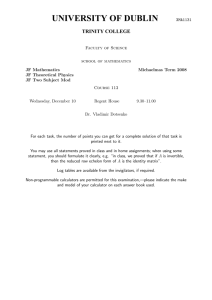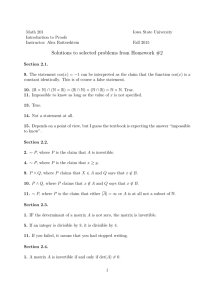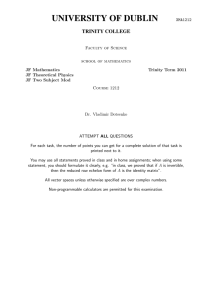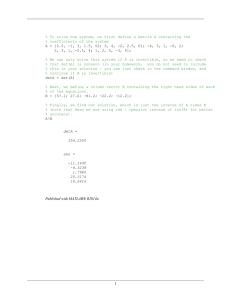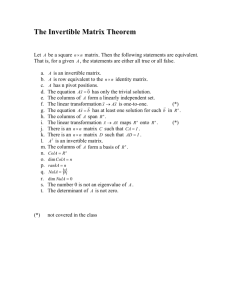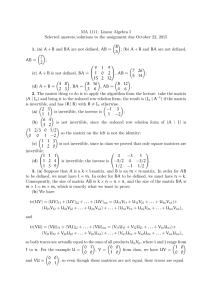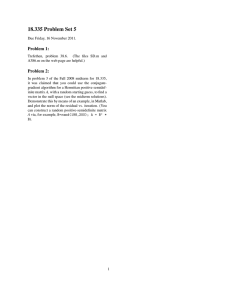MATH 152 PRACTISE PROBLEMS FOR MIDTERM 2
advertisement
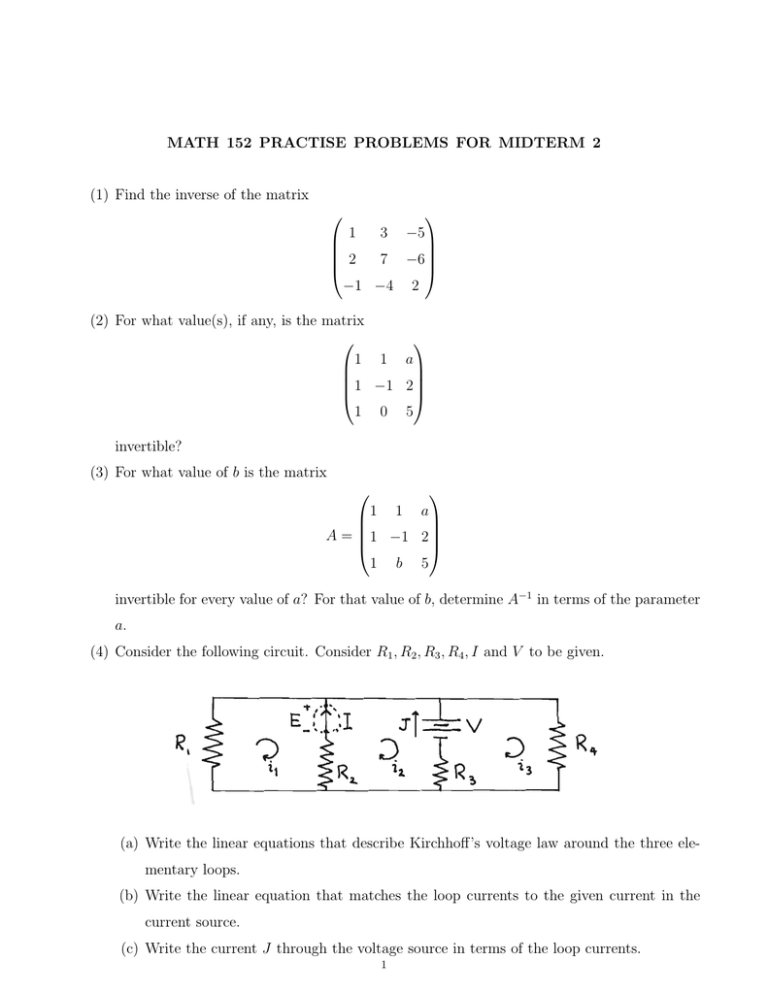
MATH 152 PRACTISE PROBLEMS FOR MIDTERM 2 (1) Find the inverse of the matrix 3 −5 1 2 7 −6 −1 −4 2 (2) For what value(s), if any, is the matrix 1 1 a 1 −1 2 1 0 5 invertible? (3) For what value of b is the matrix 1 1 a A = 1 −1 2 1 b 5 invertible for every value of a? For that value of b, determine A−1 in terms of the parameter a. (4) Consider the following circuit. Consider R1 , R2 , R3 , R4 , I and V to be given. (a) Write the linear equations that describe Kirchhoff’s voltage law around the three elementary loops. (b) Write the linear equation that matches the loop currents to the given current in the current source. (c) Write the current J through the voltage source in terms of the loop currents. 1 2 MATH 152 PRACTISE PROBLEMS FOR MIDTERM 2 (d) If R1 = R2 = R3 = R4 = 1 Ohm, V = 12 volts, and I = 3 Amperes, determine the unknowns i1 , i2 , i3 and E by solving the linear system in a) and b). (5) Consider the following circuit. where all quantities in the diagram are known. (a) Identify the unknowns in this circuit (loop currents and voltage drops across current sources). (b) Write linear equations that can be solved uniquely for these unknowns. (6) Some circuits have no solutions. (a) Show a circuit with a single loop and a single voltage source that has no solutions. (b) Show a circuit with a single loop and two current sources that has no solution. (c) Show a larger circuit that has resistors in every branch and at most one current source in each branch that has no solution. (7) Consider a random walk with the transition matrix 1 2 1 2 3 4 1 4 (a) If the walker is equally likely to be in either state initially, what are the probabilities she will be in each state after one time step? MATH 152 PRACTISE PROBLEMS FOR MIDTERM 2 3 (b) If the walker starts off in the first state, what is the probability she will be in the first state after three time steps? (8) A lab rat is in a cage with four rooms. If the rat is in room 1 it will not remain there and is equally likely to go to the other rooms. If the rat is in room 2 it is equally likely it will remain there or to to another room (i.e. all rooms with equal probability). If it is in room 3, it will only go to rooms 2 or 4, and is twice as likely to go to room 4. If it is in room 4, it always moves to room 1. Write down the transition matrix of probabilities for the rat’s random walk. (9) A random walk on three locations is described by a transition matrix P which is given below, along with some of its powers (computed by MATLAB). 1 1 0 0.2778 0.4167 0.25 0.3344 0.3314 0.3356 3 2 P = 31 12 21 P 2 ≈ 0.4444 0.4167 0.5 P 5 = 0.4447 0.4448 0.4433 1 1 0 2 0.2778 0.1667 0.25 0.2209 0.2238 0.2211 3 and the limit limn→∞ P n exists and is given by 1 3 1 3 2 9 2 9 lim P n = 49 n→∞ 4 9 1 3 4 9 2 9 Answer the following questions, doing as little arithmetic as possible. (a) If the walker starts in state 1, what is the probability he will be in state 1 after (i) 1 time step (ii) 2 time steps (iii) 5 time steps (iv) 4 time steps (v) a very long time (b) If the walker starts in state 1 and is observed for a long time, what is the fraction of time he spends in each state? (10) Find the matrix that represents projection onto the line y = 5x. Hint: Do not use the formula using θ = tan−1 (5). (11) Find the matrix that represents reflection through the line y = 5x. Hint: Use the result in the previous question and the relationship between reflection and projection operators. (12) Let T be the linear transformation in two dimensions that reflects points across the line y = 3x and then rotates points π 2 radians counter-clockwise. 4 MATH 152 PRACTISE PROBLEMS FOR MIDTERM 2 (a) Write down the matrix representation of T . (b) What is T ( 11 )? (13) What is the rotation matrix of rotating a vector about an angle of 75◦ ? Construct this matrix without using a calculator. Hint: This can be done by considering this as a composition of two rotations, first of 30◦ , and then of 45◦ . (14) Let g be a linear transformation from R3 → R2 (written g : R3 → R2 ) given by x 1 x + x 1 2 g x 2 = x1 − x3 x3 (a) Find the matrix representation of g, i.e. a matrix A such that g(~x) = A~x for all ~x in R3 . (b) Is ( 14 ) in the range of g? Justify your answer. (15) Suppose that T : R3 → R3 is linear with 1 3 0 1 T 0 = 2 T 1 = 0 0 0 0 1 (a) Find T 2 3 4 0 0 T 0 = 0 1 1 . (b) Find the matrix representation of T . (c) Is T invertible (Justify)? If so, find its inverse. (16) Suppose that T : R2 → R2 is a linear transformation, and that it is known that 1 2 1 1 T = T = 1 3 −1 3 (a) What is the matrix representation of T ? (b) What is T ( 18 )? (c) Is T invertible? If so, find its inverse. (17) For an n × n matrix A which is invertible, it is known that AA−1 = I and A−1 A = I are equivalent and uniquely determine A−1 . It is also known that (AB)T = B T AT MATH 152 PRACTISE PROBLEMS FOR MIDTERM 2 whenever either matrix multiplication is defined. Use these two facts to show that (AT )−1 = (A−1 )T for any invertible matrix A. (18) Calculate: (a) (a + ib) + (c + id) (b) (a + ib) ∗ (a − ib) (c) (a + ib)2 (d) 1 a+ib (e) 1−i 3+5i + 2+3i 1+i (f) e2i (19) Find all complex roots of z 4 = 2. 5
